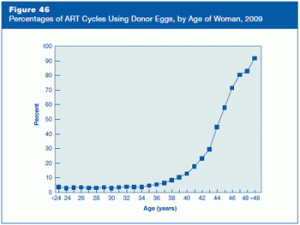
Too many women know the heartbreak of infertility. Too many women don’t know that their infertility relates to menopause, not disease.
Last week was National Infertility Awareness Week. From the organization’s website:
National Infertility Awareness Week (NIAW) is a movement that began in 1989. The goal of NIAW is to raise awareness about the disease of infertility and encourage the public to understand their reproductive health. RESOLVE: The National Infertility Association founded this movement and continues to work with the professional family building community, corporate partners and the media to:
-
Ensure that people trying to conceive know the guidelines for seeing a specialist when they are trying to conceive.
-
Enhance public understanding that infertility is a disease that needs and deserves attention.
-
Educate legislators about the disease of infertility and how it impacts people in their state.
In 2010 National Infertility Awareness Week became a federally recognized health observance by the Department of Health and Human Services.
While I am quite sympathetic to diseases which cause infertility, and the need for proper medical intervention to attempt to cure or treat the underlying cause of the infertility, in reality, many consumers of reproductive services have no disease whatsoever.
Take for example, a same-sex couple who uses these technologies to have a baby. No disease. No infertility. Or consider the “single-mother-by-choice”. No disease. No infertility.
Or what about the growing number of women who have just waited too long to have their children? These women are certainly not infertile; they are in (or entering) the period of menopause. Menopause is a natural and normal event which occurs in a woman’s life, it is not a disease which needs to be treated. The biological clock is real and as women, we must re-educate ourselves to this fact and educate our daughters to this fact. While women are living longer and healthier lives, this has no bearing on our fertility. Women still experience a dramatic decline of their fertility in their early 30s. If we want to have children, we need to have them when we are young. We risk closing the door on natural childbirth if we postpone pregnancy.
The Mayo Clinic reported that a woman’s fertility peaks between age 20 and age 24. The fertility rate remains relatively constant (at about 15–20% below maximum) through age 35. From 40 to 45, though, the decrease is a dramatic 50–95%. This translates as follows: a healthy 30-year-old woman has about a 20% chance per month to get pregnant. By age 40, however, her chance is only about 5% per month.
The following graph comes from the Centers for Disease Control and Prevention (CDC) – the only government body which gathers data (incomplete in my assessment) on the use of assisted reproductive technologies in the United States. 
Note the dramatic “percentage” rise in the use of “donor” eggs as maternal “age” increases. The use of eggs from another woman reflects the simple biological reality that, as an older woman’s fertility declines, she must turn to younger women to provide her eggs in order to conceive, bear and birth a baby.
The older birth mother is, in fact, having the younger woman’s baby – and exposing the younger woman to the detrimental health and fertility risks associated with egg harvesting procedures.
But conception is only part of an older woman’s challenge to bearing children as her fertility wanes. Advanced maternal age also heightens the risk of “fetal loss” – meaning the older mother’s age alone increases the likelihood that she simply cannot carry a baby to term. One important study noted this stark conclusion:
There is an increasing risk of fetal loss with increasing maternal age in women aged more than 30 years. Fetal loss is high in women in their late 30s or older, irrespective of reproductive history. This should be taken into consideration in pregnancy planning and counseling.
I do understand and acknowledge the heartbreak when that strong desire of women have to bear children is frustrated by age and declining fertility. But I do think National Infertility Awareness Week should focus its resources on the diseases which affect our fertility and develop a model that recognizes biological realties and practical things we can do to promote fertility.
In my next post, I will share some steps and precautions you can take in practice to safeguard and protect the gift of female fertility.










